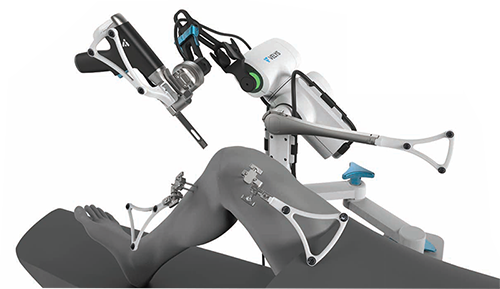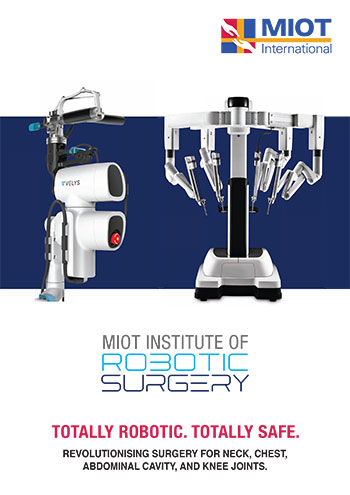MIOT Institute of Robotic Surgery
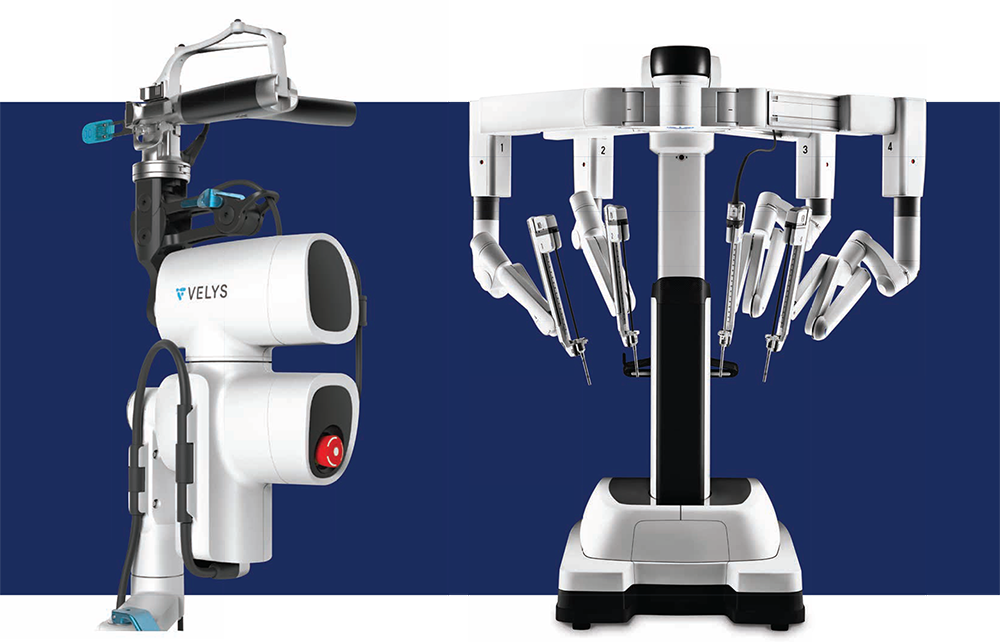

TOTALLY ROBOTIC. TOTALLY SAFE.
REVOLUTIONISING SURGERY FOR NECK, CHEST,
ABDOMINAL CAVITY, AND KNEE JOINTS.
MIOT’s Cutting-Edge Robotic Surgery
- Safer surgery with high precision
- Low healthcare costs
- No complications
- Faster recovery times
- Better patient outcomes
- Minimal pain
- Reduced blood loss
- No scar
- Shorter hospital stay
- A quicker return to quality of life
MIOT is dedicated to integrating the latest advancements in medical science to provide the best care for patients and enhance outcomes. Understanding the need for cutting-edge technology in today’s world, we have launched the MIOT Institute of Robotic Surgery. The Da Vinci Xi Robotic Surgical System and Robotic-Assisted solution for Total Knee Replacement were introduced at the right time of their development to enhance MIOT’s medical technology and improve patient outcomes. The Da Vinci Xi Robotic Surgical System is designed to perform general surgeries from the neck to the abdomen, whereas the Robotic-Assisted Total Knee Replacement is specifically used for total knee replacement surgeries.
Da Vinci Xi Robotic Surgical System
Robotic surgery is an advanced form of minimally invasive or laparoscopic (small incision) surgery in which surgeons perform the surgery using a computer-controlled robot, with the surgeon having complete control of the robotic system. This technology allows complex surgeries that require high precision to be performed safely without damaging surrounding tissues or organs. Robotic technology enhances precision, minimises surgical complications, and improves patient outcomes. This technology ensures a high level of safety for patients undergoing over 140 different types of surgeries. The enhanced safety of patients is further increased by the Robotics-Assisted Intraoperative Ultrasound System. The transducer of this advanced ultrasound system, placed inside the body, provides high-resolution images with great anatomical details during surgery. These real-time images are captured from all angles with full robotic articulation. It provides greater accuracy and precision to ensure the identification of the entire tumour surface for complete tumour resection.
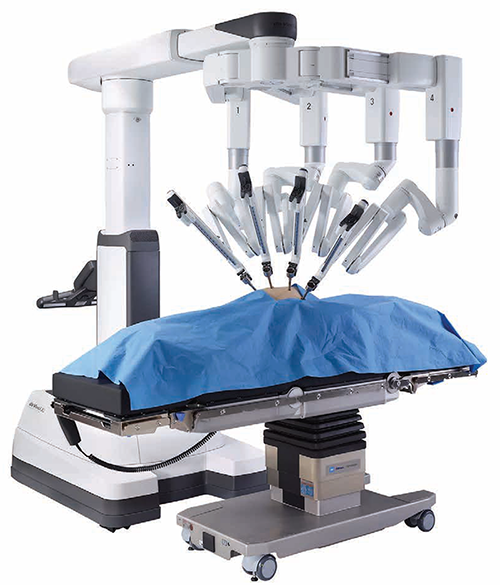
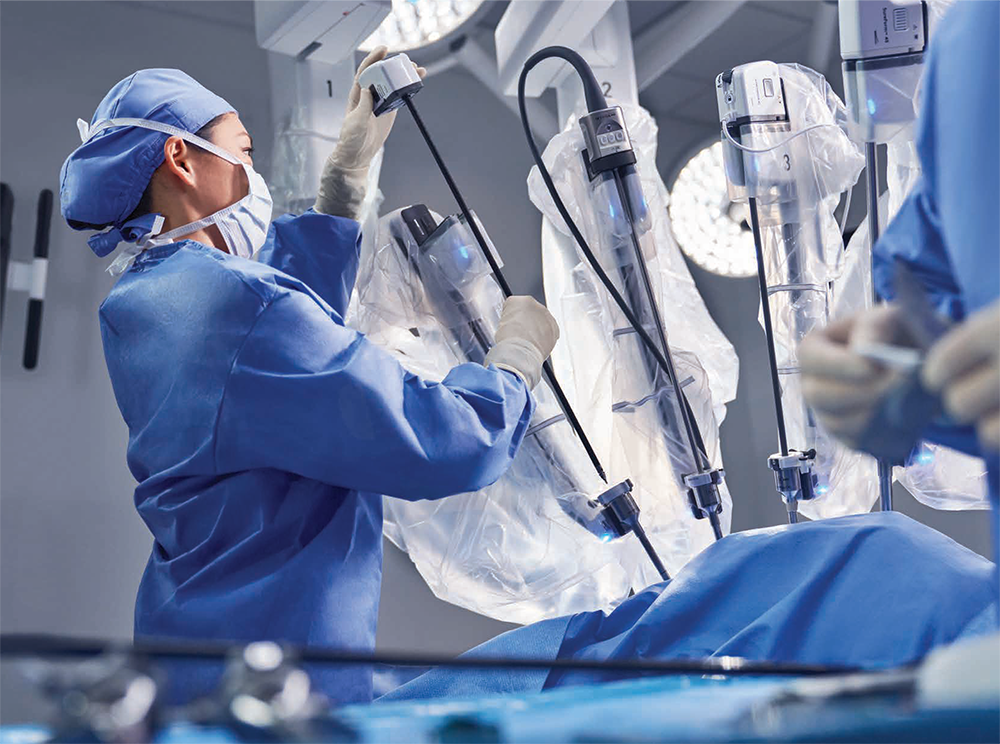
Concerning Factors of Surgery
No More Fear of Surgery: People often delay surgery due to concerns about safety, recovery, and regaining quality of life. This may worsen their condition and eventually lead to critical health issues. However, these fears can now be alleviated with the use of Robotic Surgery.
Robotic technology provides a great comfort for the surgeons. The surgeon sits in the surgeon console and performs the surgery. This eliminates their fatigue and improves their performance. This not only reduces the risk of errors but also improves overall patient outcomes, making surgery safer and more effective.
The advancements include
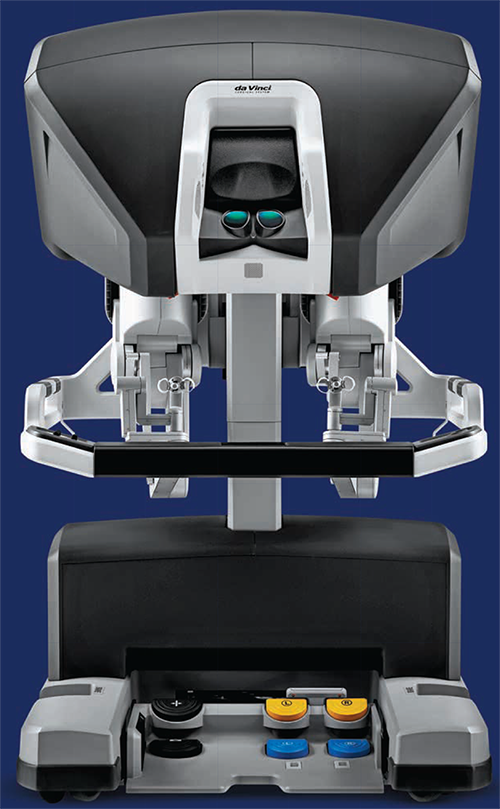




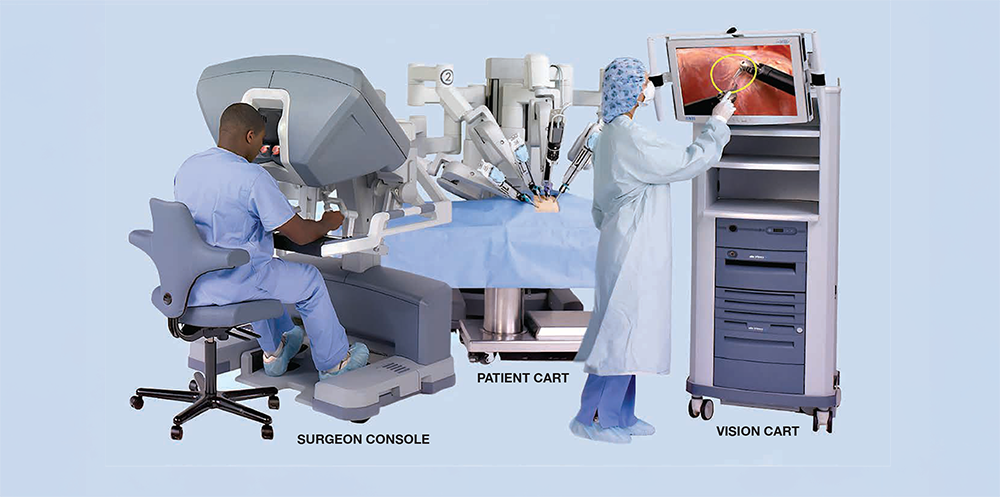
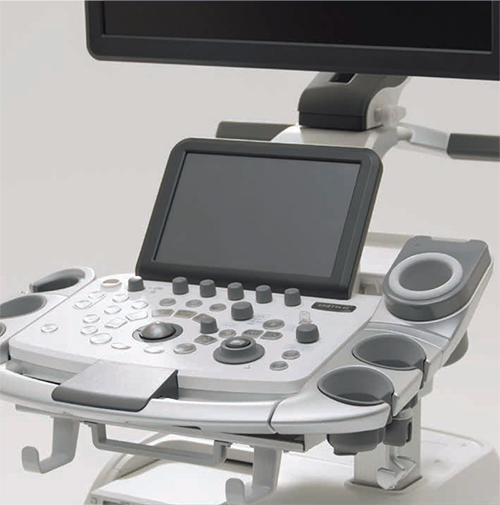
Robotics-assisted intraoperative ultrasound system The success of surgery largely depends on an accurate diagnosis. Diagnostic imaging is typically performed a day or even a week before surgery. The actual size or depth of a tumour or other abnormality may change by the time of the procedure, potentially impacting the surgical outcome. This advanced Robotics-Assisted Intraoperative Ultrasound System aids surgeons by allowing them to locate and accurately visualise anatomical abnormalities in real-time during surgery. It helps precisely identify the tumour’s location, depth, and borders, making it easier to distinguish between the tumour and normal tissue.
- Free Yourself from Financial Worries: MIOT understands the unique needs of patients and is dedicated to providing them with the best treatment. Advanced care doesn’t have to come with a high price. By adopting world-class innovations, MIOT offers cutting-edge robotic technology at an affordable cost. Additionally, by minimising complications and shortening hospital stays, this technology reduces overall healthcare expenses, making it accessible to all patients.
- Regaining Quality of Life: Shorter hospital stays and faster recovery times enable patients to return to their daily lives and loved ones more quickly, reducing stress for both patients and their families.
- Shorter Recovery Times: People may feel anxious about the longer recovery time and the emotional drain post-surgery. However, in robotic surgery, the smaller incisions, reduced blood loss, pain, risk of complications, and decreased rate of infection lead to shorter hospital stays and faster recovery times than traditional surgical methods.
- Minimising Blood Loss: This advanced technology helps prevent the dissection of unintended small blood vessels, thereby minimising blood loss effectively.
- Diminishing Scars and Pain: This technology involves smaller incisions and gentle dissection, resulting in less tissue trauma and reduced pain. It is equipped with a remote centre control that prevents side-to-side force on the tissue, further minimising pain and scarring.
How Does Robotic Surgery Score Over Laparoscopic Surgery?
LAPAROSCOPY |
ROBOTIC SURGERY |
|---|---|
| Less-Magnified 2D View: The surgeon manually controls the instruments and views the surgical site using a 2D camera. | 10 Times Magnified 3D View: The surgery is performed with robotic tools and is aided by a binocular lens and a 3D HD camera. |
| No Tremor Filter: The tremors in the surgeon’s hand movements are not f iltered out. | Tremors Are Filtered Out: The motions are scaled and tremors are filtered out, enhancing the surgical precision. |
| Difficult to Access Complex Locations: The laparoscopic ultrasound can not reach difficult angles. | Access Complex Locations: The surgeons can locate and visualise anatomical abnormalities during surgery with great precision. The transducer fully articulates to reach complex angles. |
| Less Depth Perception: Unable to accurately assess the tumour’s depth. | Better Depth Perception: The 3D HD camera and advanced ultrasound system enable surgeons to better understand the depth perception of the tumour. |
| Chances of Failure Rate are More: With lower image resolution and reduced precision, the chances of failure are higher compared to robotic surgery. | Enhances Patient Outcomes: Accurate dissection, complete tumour resection, minimal pain, and decreased risk of infection enhance better patient outcomes. |
| More Blood Loss: The risk of dissecting unintended blood vessels is higher with a less magnified view, resulting in greater blood loss. | Less Blood Loss: The gentle and accurate dissection prevents dissecting the unintended small blood vessels, resulting in less blood loss. |
| More Pain: The instruments are rotated during the procedure, which applies pressure on the incision point, resulting in more pain. | Minimal Pain: It is designed in a way that allows the robotic tools to rotate around the fixed point at the incision site. The remote centre technology prevents the side-to-side force applied during surgery, thereby minimising the damage to the body and reducing pain and scarring. |
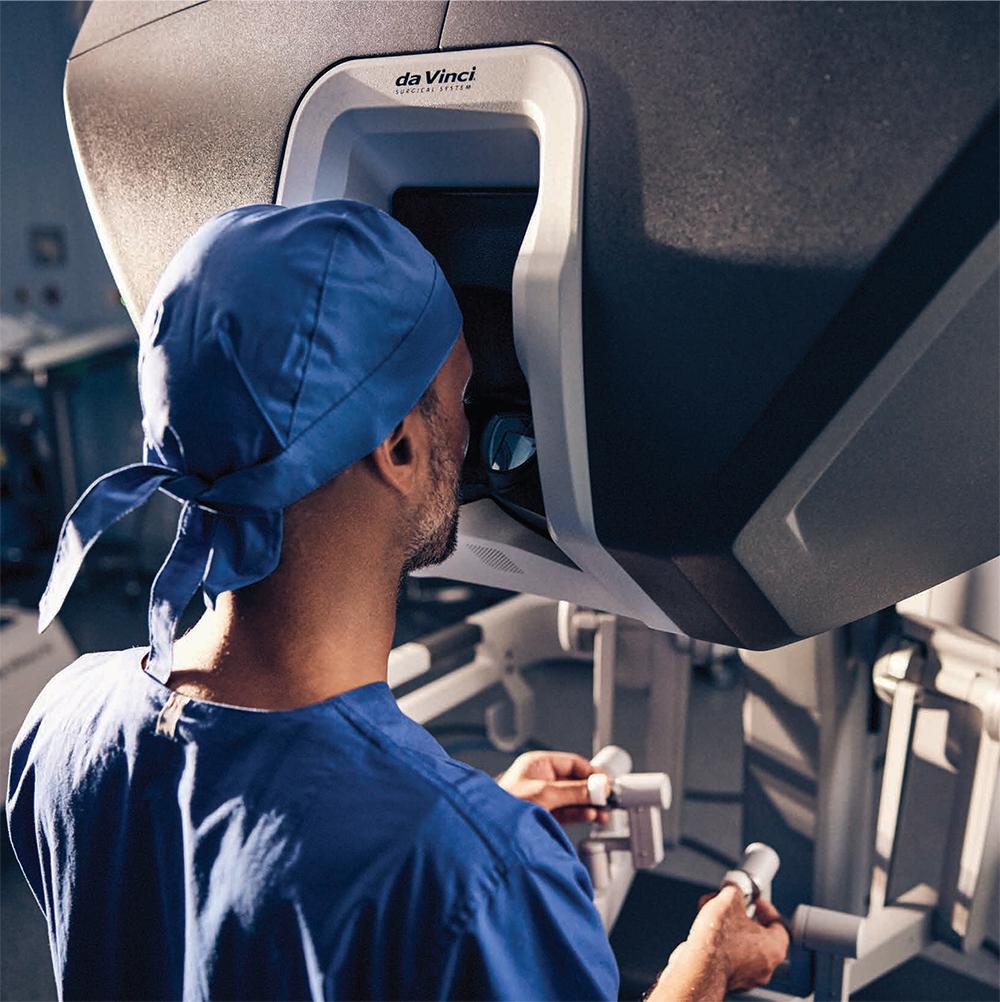
How is Robotic Surgery Performed?
The surgeon sits in the console and views the surgical area through the binocular lens, which provides a 10 times magnified view of what the human eye sees. Using hand controls, endowrist instruments are operated. The surgeon’s hand movements are precisely replicated by the endowrist instruments inside the patient’s body. This technology enables surgeons to differentiate between normal and cancerous tissue and live and dead tissue. It also ensures that cancer tumours are completely removed.
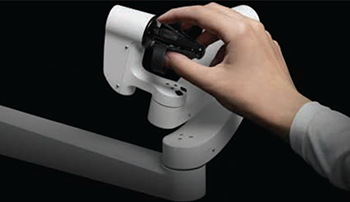
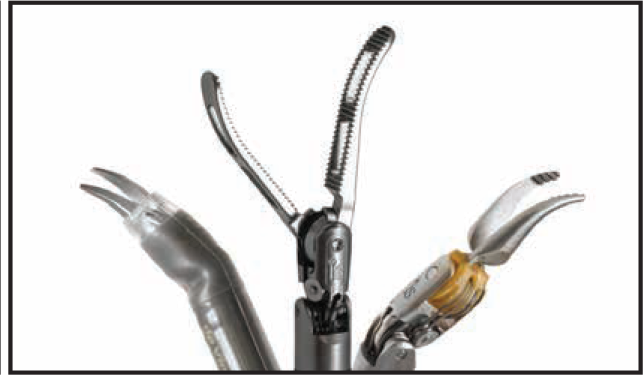
Types of Surgeries Performed Using Robotic Surgery
- All cancer surgeries (Chest and Abdomen)
- Gastrointestinal (Oesophagus, Stomach, and Colorectal)
- Nephrological (Kidney)
- Bariatric (Weight loss)
- Hepatopancreaticobiliary
- Urologic (Urinary Bladder)
- Gynaecologic (Hysterectomy)
- Head and Neck (Thyroid, Neck dissection, and Deep oral cavity tumour)
- Cardiothoracic (Heart and Lungs)
- General surgery (Cholecystectomy and Hernia repair)
- Paediatric surgery
Robotic-Assisted Solution for Total Knee Replacement
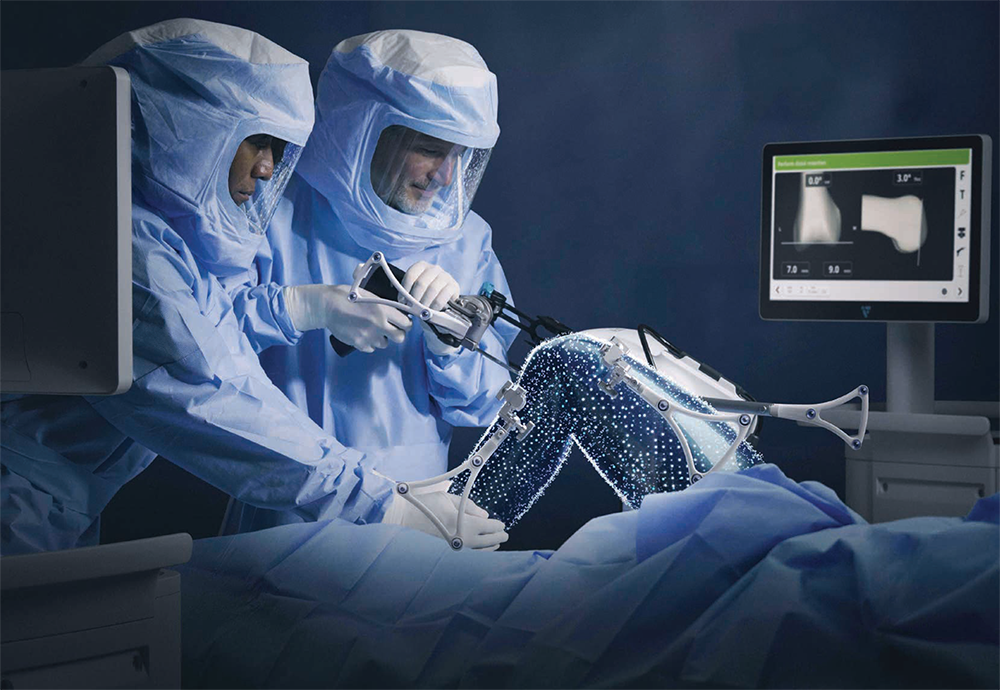
Advancements
- Accuracy: The robotic system assists surgeons in accurately removing damaged bone and achieving precise knee alignment.
- Integrated CT-free Technology: Optimises implant placement, allowing adjustments as small as 0.5 mm or 0.5 degrees for maximum precision.
- Personalised Surgery: By accessing this cutting-edge technology, surgeons gather details and data from the patient’s knee and select the right implant fit based on the individual’s anatomy.
- Real-Time Decision Making: Equips surgeons with the information needed to preserve the soft tissue envelope, predict joint stability, and support the restoration of natural knee function.
- Increased Implant Lifespan: The precise positioning of the implant increases the longevity of knee implants.
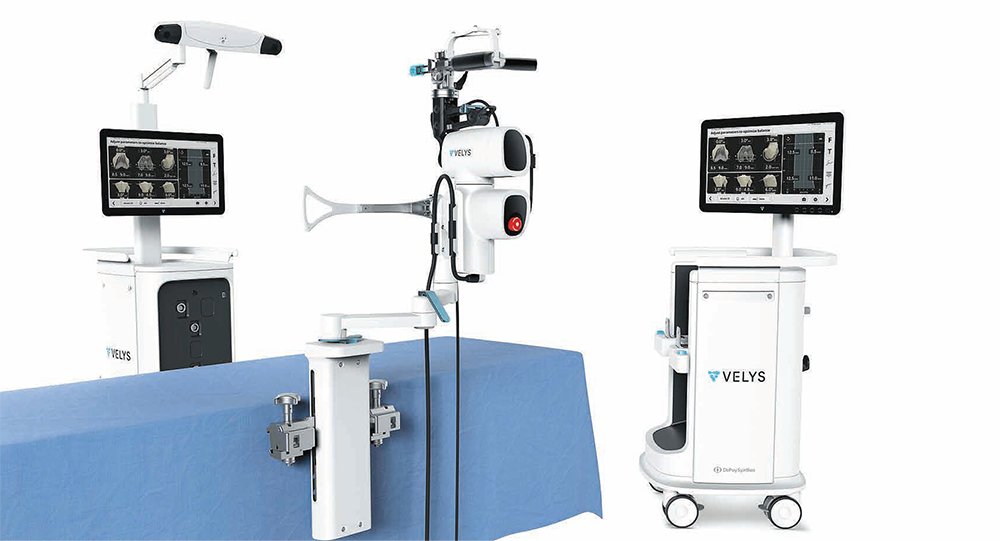
Advantages Over Conventional Treatments
- Accurate bone cuts
- Balanced gaps: Advanced technology helps maintain symmetrical spacing between bones, allowing for smooth, natural knee motion and improved joint stability
- Targeted alignments: Personalised alignment based on the patient’s specific anatomy results in an effective knee replacement
- Reduced cardiopulmonary complications
Benefits for the Patients
- Greater range of knee motion (improved ability to bend and flex the knee after surgery)
- Less pain compared to traditional methods
- Shorter hospital stay
- Faster recovery time
- Less blood loss
- No pre-surgery CT scans – avoiding harmful radiation, added cost, and time
Who is Recommended to Undergo Robotic-Assisted Knee Replacement?
It is recommended for patients suffering from knee osteoarthritis who have a fear of undergoing surgery. This state-of-the-art technology enables surgeons to perform the surgery with minimal soft tissue damage, thereby helping patients recover faster without much surgical pain.
Asian patients, in particular, are advised to undergo robotic surgery due to the high prevalence of bowing of long bones among them.
For patients who are over 70 years of age, this technology helps reduce the risk of fat embolism. Younger patients under 50 with arthritis also benefit from robotic surgery, as it increases the lifespan of implants.
Robotic assistance also helps surgeons to operate on patients who are obese, morbidly obese, or those who already have implants in their thigh or leg bones, without compromising on accuracy and outcomes.
MIOT’s Expertise in Robotic Surgery
Supported by a team of 250 dedicated full-time doctors, we work collaboratively to provide the best treatment for the patients. Now, with the addition of robotic surgery, we have further advanced our capabilities to enhance patient outcomes. Robotic surgery requires specialised training and experience. At MIOT, our surgeons are not only trained in this advanced technique but also have several years of experience with robotic systems. With their expertise, MIOT’s surgeons perform complex surgeries with exceptional precision, minimising risks, improving surgical outcomes, and contributing to faster recovery times.
With MIOT’s Robotic Surgery, Patients Experience:
- A regained quality of life
- Safer surgery with high precision
- Low healthcare costs
- No complications
- Faster recovery times
- Better patient outcomes
- Shorter hospital stays
- Minimal pain
- No scar
- Reduced Blood loss
